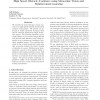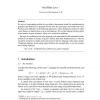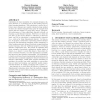886 search results - page 16 / 178 » Learning Distance Functions using Equivalence Relations |
ICML
2005
IEEE
14 years 10 months ago
2005
IEEE
We consider the task of driving a remote control car at high speeds through unstructured outdoor environments. We present an approach in which supervised learning is first used to...
ICML
2007
IEEE
14 years 10 months ago
2007
IEEE
The k-Nearest Neighbors algorithm can be easily adapted to classify complex objects (e.g. sets, graphs) as long as a proper dissimilarity function is given over an input space. Bo...
APAL
2008
13 years 9 months ago
2008
We solve a longstanding problem by providing a denotational model for nondeterministic programs that identifies two programs iff they have the same range of possible behaviours. W...
KDD
2006
ACM
14 years 10 months ago
2006
ACM
Calculation of object similarity, for example through a distance function, is a common part of data mining and machine learning algorithms. This calculation is crucial for efficie...
JCSS
2007
13 years 9 months ago
2007
We introduce a combinatorial dimension that characterizes the number of queries needed to exactly (or approximately) learn concept classes in various models. Our general dimension...



